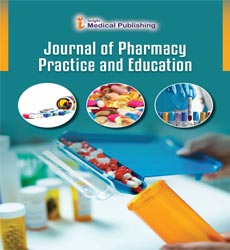An Approach to Clinical Trials
Thomas A. Kent*
Department of Neurology, Baylor College of Medicine, McNair Campus, Houston, USA
- *Corresponding Author:
- Thomas A. Kent
Department of Neurology, Baylor College of Medicine
McNair Campus, 7200 Cambridge Street, Houston, Texas
USA
Email: tkent92@tamu.edu
Received Date: September 02, 2021; Accepted Date: September 16, 2021; Published Date: September 23, 2021
Citation: Kent TA (2021) An Approach to Clinical Trials. J Pharma Prac Edu Vol. 4 No.5: 40
Abstract
Description
The new focal point of government financing on similar viability research highlights the significance of clinical trials in the act of proof based medication and medical care change. The effect of clinical trials not just reaches out to the individual patient by building up a more extensive determination of successful treatments, yet additionally to society all in all by upgrading the worth of medical services gave. Nonetheless, clinical trials additionally can possibly present obscure dangers to their members, and one-sided information separated from defective clinical trials might prompt the accidental damage of patients [1]. In spite of the fact that leading a very much planned clinical preliminary might seem clear, it is established on thorough philosophy and oversight represented by key moral standards.
Pre-clinical trails
Pre-clinical examinations incorporate creature studies and assessments of medication creation and immaculateness. Creature considers investigate: 1) the medication's wellbeing in dosages identical to approximated human openings, 2) pharmacodynamics (i.e., instruments of activity, and the connection between drug levels and clinical reaction), and 3) pharmacokinetics (i.e., drug assimilation, dispersion, digestion, discharge, and potential medication drug associations). This information should be submitted for IND endorsement if the medication is to be additionally concentrated in human subjects [2].
Phase-I trails
The phase I trials ("human pharmacology" studies) are the first instance in which the new investigational specialist is studied in people, and are normally performed open name and in few "solid" and additionally "diseased" volunteers. The MTD (maximum tolerated dosage), or the medication portion before a portion limiting toxicity, can be determined using various statistical designs. Portion escalation depends on exceptionally strict criteria, and subjects are firmly followed for evidence of medication toxicity over a sufficient period. There is a risk that subjects who volunteer (or the genuine physicians who select patients) for phase I studies will misinterpret its objective as therapeutic. Improvements to the course of informed consultant could assist with dispelling a portion of these interruptions while still maintaining satisfactory enlistment numbers.
Phase-II trails
Phase II trials, likewise called as "therapeutic exploratory" trials, are generally bigger than phase I studies, and are led in few volunteers who have the disease of interest. They are designed to test security, pharmacokinetics, and pharmacodynamics, yet may likewise be designed to address questions essential to the planning of phase III trials, including determination oofp timal dosaegs, portion frequencies, administration courses, and endpoints. Nonetheless, the modest number of participants and primary wellbeing worries within a phase II trial normally limit its ability to establish efficacy, and in this manner upholds the necessity of an ensuing phase III trial. At the conclusion of the initial trial phases, a meeting between the sponsor(s), investigator(s), and FDA might happen to review the preliminary information, IND, and ascertain the viability of progressing further to a phase III trial (including plans for trial design, size, results, wellbeing concerns, examinations, information collection, andca se report tsructures) [3]. Manufacturing concerns may likewise be discussed as of now.
Phase-III trails
In view of earlier examinations exhibiting drug wellbeing and expected viability, a phase III preliminary (additionally alluded to as a "helpful corroborative," "near adequacy," or "critical preliminary") might be sought after. This phase of medication evaluation is directed in a bigger and frequently more different objective populace to exhibit and additionally affirm viability and to recognize and gauge the occurrence of normal antagonistic responses. The most well-known kind of phase III trials, near adequacy trials (regularly alluded to as "prevalence" or "fake treatment controlled trials"), contrast the intercession of interest and either a standard treatment or a fake treatment. Another kind of phase III preliminary, the equivalency preliminary (or "positive-control study"), is intended to discover whether the trial treatment is like the picked comparator inside some edge pre-specified by the specialist.
Phase-IV trails
Phase IV trials, likewise called as "remedial use" or "postadvertising" xaemines, ea robservational investigations performed on FDA-endorsed medications to: 1) distinguish more uncommon unfavorable responses, and 2) assess cost and additionally druge ffectiveness in infections, populaces, or portions like or notably unique in relation to the first examination populace [4].
Conclusion
To offer patients the best and most secure treatments conceivable, comprehend the key ideas associated with performing clinical trials. Understanding the moral statutes and guidelines behind preliminary plans may likewise assist with keying partners react to future exploration predicaments at home and abroad. In addition, all around planned and executed clinical trials can contribute essentially to the public work to work on the effectiveness and productivity of medical services.
References
- Lansimies AH, Laitinen T, Rauramaa R, Pietilä AM (2010) Evaluation of informed consent in health research: a questionnaire survey. J Scand Car Sci 24(1):56–64.
- Dickert N, Grady C (1999) What’s the price of a research subject? Approaches to payment for research participation. J N Engl Med 341(3): 198–203.
- Echt DS, Liebson PR, Mitchell LB (1991) Mortality and morbidity in patients receiving encainide, flecainide, or placebo. The cardiac arrhythmia suppression trial. N Engl J Med 324(12):781–788.
- Foddy B (2009) A duty to deceive: placebos in clinical practice. J Am Bioeth 9(12):4–12.
Open Access Journals
- Aquaculture & Veterinary Science
- Chemistry & Chemical Sciences
- Clinical Sciences
- Engineering
- General Science
- Genetics & Molecular Biology
- Health Care & Nursing
- Immunology & Microbiology
- Materials Science
- Mathematics & Physics
- Medical Sciences
- Neurology & Psychiatry
- Oncology & Cancer Science
- Pharmaceutical Sciences
